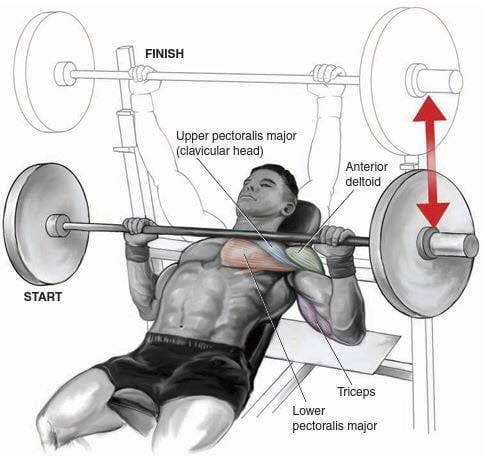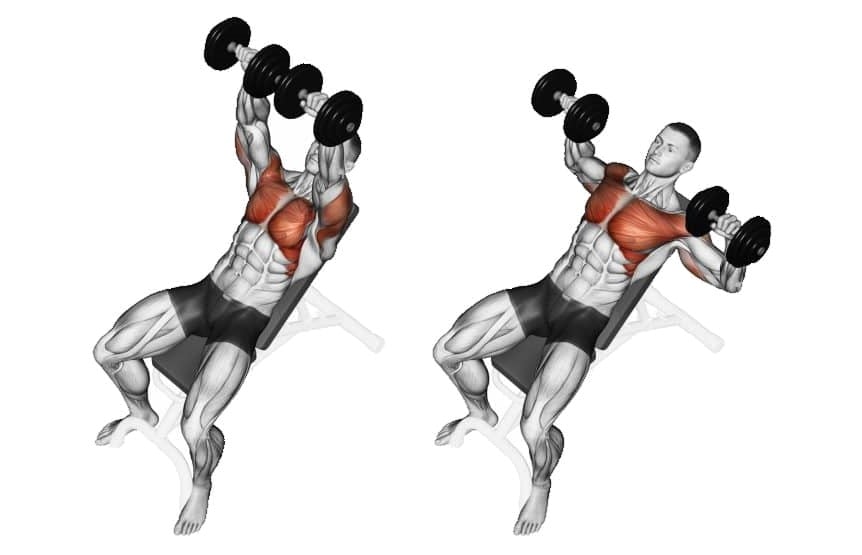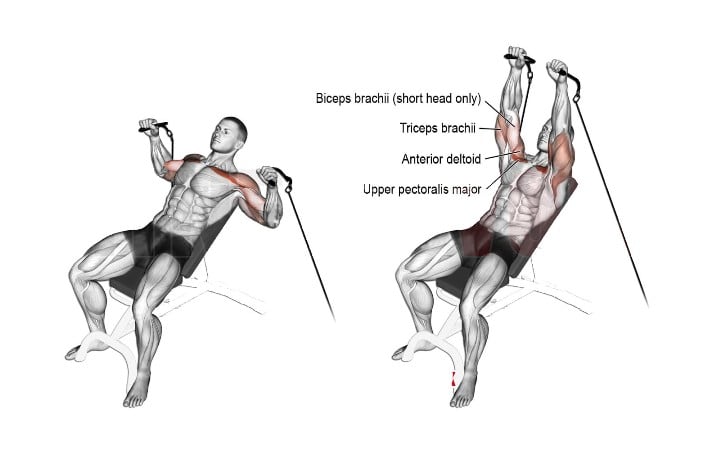Are you looking to maximize your incline bench press workouts? Understanding the correct angle for an incline bench press is crucial for targeting the upper chest muscles effectively and minimizing injury risk.
The incline bench press is a popular exercise that targets the chest, shoulders, and triceps. However, many people get the angle wrong when they want to emphasize the upper chest.
In this comprehensive guide, we’ll delve into the science behind the optimal incline angle for maximizing chest growth. We also provide practical tips on how to change the same as per requirement.

- What Is an Incline Bench Press
- Muscles Worked During Incline Chest Press
- The Importance of the Right Angle Of Incline Chest Press
- Muscle Activation
- Joint Health
- Optimal Angle for Incline Bench Press
- Incline Bench Press Variations
- 1. Barbell Incline Bench Press
- 2. Incline Dumbbell Press
- 3. Smith Machine Incline Press
- 4. Incline Cable Bench Press
- Conclusion
- FAQs
- Is The Incline Bench 30 Or 45 Degrees?
- References
What Is an Incline Bench Press
The incline bench press is a compound exercise that primarily targets the upper chest muscles, also known as the clavicular head of the pectoralis major.
The incline barbell press is a variation of the flat bench press, where the bench is set at an incline, typically between 15 and 45 degrees.
This angle engages the upper pectoral muscles and calls upon the synergistic muscles for assistance. The anterior deltoids (front shoulders) and the triceps brachii, play significant supporting roles.
The higher the bench’s angle, the more the exercise emphasizes the shoulders, hence the need to find that sweet spot for optimal chest engagement.
Want to take your gains to the next level? Discover your daily calorie needs with our free TDEE calculator.
Muscles Worked During Incline Chest Press
The incline bench press primarily works the upper pectoralis major muscles, in addition to its target to the main pec muscle.
The incline chest press has the involvement of several synergist muscles, these muscles include,
- Rhomboids,
- Anterior deltoids, and
- Triceps brachii,
- Latissimus dorsi.
A handful of other muscles worked or play the role of stabilizer muscles, including your
- Biceps brachii,
- Brachialis,
- Wrist flexors.

The Importance of the Right Angle Of Incline Chest Press
The angle of incline in bench pressing is pivotal for two primary reasons: muscle activation and joint health. When you adjust the angle of the bench, you change which muscle fibers are most engaged.
An angle that’s too shallow mimics a flat bench press, placing more emphasis on the middle chest muscles rather than the upper chest.
Conversely, an angle that’s too steep starts to resemble a shoulder press, shifting the focus and strain onto the deltoids rather than the chest.
Muscle Activation
- Optimal Angle (30-45 degrees): The sweet spot for most individuals lies within a 30-45 degree range. This angle is ideal for maximizing the engagement of the upper pectoral muscles.
- Shallow Angle (<30 degrees): A lesser incline might not sufficiently target the upper chest area. It is potentially hindering the balanced development of the pectoral muscles.
- Steep Angle (>45 degrees): A steeper angle increases activation of the deltoid muscles. And may lead to an imbalance in muscle development and reduced effectiveness for upper chest targeting.
Joint Health
- Proper Angle: Helps maintain a natural movement pattern. It allows the shoulder joint to move freely without impingement. It is crucial for long-term shoulder health.
- Too Shallow: It may not pose a significant risk to joint health. It could lead to muscle imbalances as it doesn’t adequately target the intended muscle groups.
- Too Steep: Angles steeper than 45 degrees can increase the risk of shoulder impingement. When the angle is too steep, the scapula may not move as freely. It can lead to pain and potential injury over time.

Optimal Angle for Incline Bench Press
The incline bench press is one of the best upper chest exercises, but there’s one major problem: the front deltoid likes to dominate the movement, which prevents us from getting the maximum benefit out of it.
The anterior deltoids and the upper chest are very close to each other, which means that one of the two can start dominating the other if we don’t do the exercise correctly. When you do the incline bench press, it’s important to get the angle of the bench correct.
What angles should I use during the incline bench press to hit the upper chest the most? Or whether it’s better to do High Incline and Low Incline chest presses.
Research shows that doing the Incline bench press at a 30-degree angle is the best way to work on the upper part of your chest.
Even though 30 degrees may seem like a small angle, it is the proper angle to train your upper pecs and minimize the effect on the anterior deltoid muscles.
If you set the incline bench press angle to 60 degrees, which people will use for an incline bench press, then you’re going to shift the focus from the upper chest to the anterior deltoid.
An upright position will maximize the attention that the front delts get because the arms will move in a straight line up against gravity in an overhead pressing motion.
Incline Bench Press Variations
The standard barbell incline bench press is a great mass and strength builder, but don’t be afraid to switch it up. Variations like the incline dumbbell press, incline smith machine press, and incline cable press offer new angles of attack for upper chest and shoulder growth.
Changing your grip width or arm position further alters the stimulus. Work these incline bench press variations into your chest routine to target different muscle fibers, enhance mind-muscle connection, and bust through plateaus.
1. Barbell Incline Bench Press
Barbell incline bench press is a compound upper-body exercise that targets multiple muscle groups, including the chest, shoulders, and triceps.
The Incline bench press is a variation of the traditional flat bench press, where the lifter’s body is fixed in an incline position.
This exercise helps to build a more defined and balanced chest appearance. It focuses on the upper chest more.

How To Do Incline Bench Press
- Set an adjustable bench to an incline of around 30–45 degrees.
- Lie back on the bench with your feet flat on the floor.
- Grasp the barbell with a grip slightly wider than shoulder-width apart.
- Grip the barbell with your hands slightly wider than shoulder-width apart.
- Slowly lower the barbell towards your mid-chest, keeping your elbows slightly tucked in.
- Pause briefly, then push the barbell back up to the starting position.
- Do 8–10 reps.
Know More: Barbell Chest Exercises For Bigger And Stronger Pecs
2. Incline Dumbbell Press
If you’re looking for straightforward dumbbell upper chest exercises to add to your routine, the Incline dumbbell press is a great staple exercise to get you started.
The incline dumbbell press targets the upper chest muscles similarly to the barbell incline bench press, but offers some unique benefits. Using dumbbells allows for a greater range of motion at both the bottom and top of the movement.
Each arm can move independently, which provides a fuller stretch and peak contraction of the pectoral muscles. This enhanced range of motion enables more complete chest activation and development compared to the bar version.

How To Do Incline Dumbbell Press
- Set an adjustable bench to an incline angle between 30–45 degrees.
- Lie back on the bench and hold a dumbbell in each hand.
- Bring the dumbbells up one at a time.
- Hold them straight above your shoulders with palms facing forward.
- Lower the dumbbells down slowly until they are even with your chest.
- Once the dumbbells lightly touch your chest, reverse the motion to the starting position.
- Squeeze your chest muscles at the top and hold for a second.
- Slowly lower back down again with control. Do not let the dumbbells bounce off your chest.
- Repeat for the desired number of repetitions.
3. Smith Machine Incline Press
The Smith machine provides a guided path, reducing the need for stabilizing muscles and allowing you to focus more on the targeted upper chest muscles.
It is a great exercise for beginners to get a feel for incline pressing and adapt to the movement pattern
The presence of safety catches on the Smith machine allows for independent lifting without the need for a spotter.

How To Do Smith Machine Incline Press
- Adjust the bench to an inclined position.
- Position yourself on the bench with your feet flat on the floor for stability.
- Grasp the barbell with an overhand grip slightly wider than shoulder-width apart.
- Unrack the barbell by lifting it off the safety catches and holding it directly above your chest.
- Lower the barbell slowly and under control until it touches your upper chest.
- Push the barbell back up along the same path until your arms are fully extended, but avoid locking out your elbows.
- Repeat for the desired number of reps.
4. Incline Cable Bench Press
The Incline cable bench press has a unique benefit. In barbell and incline dumbbell bench presses, the resistance is directly downward, and your triceps brachii take over much of the force from your chest at the top of the press.
In contrast, the incline cable bench press maintains more focus on your upper pectoralis major throughout the movement.
The resistance comes from an angle, so you have to push the stirrups upward and pull them inward at the top of the movement.

How To Do Cable Incline Bench Press
- Set an incline bench at a 30 to 45-degree angle.
- Attach stirrup handles to the low pulleys and lie down on the bench with your feet flat on the floor.
- Exhale as you extend your elbows up to move your arms up and inwards until your hands meet.
- Squeeze your upper chest at the top of the movement.
- Then inhale as you slowly release back to the starting position.
- Repeat as many repetitions as are desired.
Conclusion
The incline bench press is an effective exercise that targets the upper chest muscles, shoulders, and triceps. The correct angle of incline press increased muscle activation and reduced injury risk.
If you are new to the incline bench press, I encourage you to try it out next time you are at the gym. Experiment with different angles and variations to find what works best for you.
With practice, you will be able to perform the incline bench press safely and effectively.
FAQs
Is The Incline Bench 30 Or 45 Degrees?
Research shows that the correct angle of the Incline Bench Press should be 30 degrees from flat to target the upper chest. So, it is best to set the bench at about 30 degrees inclined. It is important not to go too upright because then the stress will shift to the shoulders rather than the chest.
References
- Influence of bench angle on upper extremity muscular activation during bench press exercise. Lauver, J. D., Cayot, T. E., & Scheuermann, B. W. (2015). European Journal of Sport Science, 16(3), 309-316. doi:10.1080/17461391.2015.1022605. URL: https://www.tandfonline.com/doi/full/10.1080/17461391.2015.1022605, accessed on 24.08.2020
- Rodríguez-Ridao, D., Antequera-Vique, J. A., Martín-Fuentes, I., & Muyor, J. M. (2020). Effect of Five Bench Inclinations on the Electromyographic Activity of the Pectoralis Major, Anterior Deltoid, and Triceps Brachii during the Bench Press Exercise. International Journal of Environmental Research and Public Health, 17(19).
- An Electromyography Analysis of 3 Muscles Surrounding the Shoulder Joint During the Performance of a Chest Press Exercise at Several Angles. Trebs, A. A., Brandenburg, J. P., & Pitney, W. A. (2010). Journal of Strength and Conditioning Research, 24(7), 1925-1930. doi:10.1519/jsc.0b013e3181ddfae7

Manish brings over 10 years of hands-on experience in weight lifting and fat loss to fitness coaching. He specializes in gym-based training and has a lot of knowledge about exercise, lifting technique, biomechanics, and more.
Through “Fit Life Regime,” he generously shares the insights he’s gained over a decade in the field. His goal is to equip others with the knowledge to start their own fitness journey.
